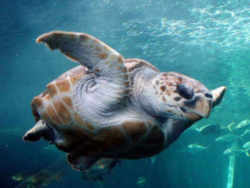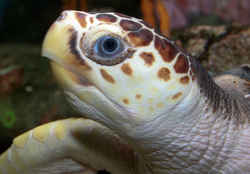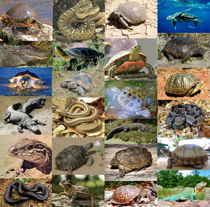
Florida Symbols
Florida Salt Water Reptile
Loggerhead Sea Turtle

(Caretta Caretta)
Adopted on July 1, 2008.
According to the Florida Fish and Wildlife Conservation Commission (FWC), the loggerhead sea turtle (scientific name: Caretta caretta) is the most common sea turtle to nest along Florida's coast. Its designation as the official Florida saltwater reptile on July 1, 2008 recognizes this threatened species at a time when loggerhead nest counts are down.
Typically, about 90 percent of loggerhead nests in the United States are in Florida. Almost half the loggerhead nests in the world occur on Florida's beaches.
Over the past 19 years, Florida's loggerhead sea turtle nest counts have declined 37 percent. The species nests from late April until September in Florida. Hatchlings emerge after incubating in warm sand for two months.
The FWC credits students from the Florida State University School's Middle School Science Honors Class for pursuing the state symbol designation during the 2007-08 school year and the 2008 legislative session.
The loggerhead sea turtle was one of four symbols the students proposed for addition to the state list. Working with State Representative Curtis Richardson (D-Tallahassee), the students provided information and answered questions regarding the symbols. Richardson amended an already-existing state symbol bill to include the loggerhead sea turtle.
Florida Salt Water Reptile: Loggerhead Sea Turtle

The only remaining extant member of this genus is the loggerhead sea turtle. It is known for it's relatively large head (thus the name Loggerhead).
Loggerheads have a characteristic large head, but it is not because they house a large brain, instead, the space is used for their closing muscles to the jaws. There are two subspecies to Caretta caretta , the other is C. caretta gigas, found in the Pacific and Indian Oceans. C. Caretta caretta differ from gigas by the number of marginal laminae (C. Caretta caretta have 7-8 while gigas have 7-12). Also, the neural bones of the Atlantic species are not interrupted by pleurals, and their front flippers possess two claws. The carapace is reddish-brown with five or more pleural scutes. The broad head varies from reddish-olive brown to yellow.
Characteristics of the Loggerhead Sea Turtle
Food Habits
Atlantic loggerheads are carnivorous and eat sponges, jellyfish, horseshoe crabs, clams, and oysters. They have extra powerful jaws which enable them to easily crush the hard shells of their prey.
Reproduction
Caretta caretta reaches sexual maturity at 12-35 years when their shells are no longer than 50 cm., with Lutz and Musick (1997) reporting 25-35 years. Copulation occurs at sea at no particular time of day or night. Nesting occurs throughout the summer, predominately at night on ocean beaches with well drained sand dunes. The eggs, which are 40-42 mm in diameter, are laid in the flood of spring tides. The eggs are placed in a nest, which is usually chosen in an undisturbed area of well- drained dunes or grassy vegetation. The female comes ashore and climbs up to the high tide line, she then stops and thrusts her snout in the sand to make a shallow hole. Once the hole is dug and the eggs are laid, the nest is then covered by the turtle using her hind flippers. Incubation lasts for a period of 31-65 days. There is usually 120 eggs per clutch, and the female lays two clutches at an interval of thirteen days. The females come ashore to nest only at night in the spring and summer. Eggs require up to 60 days to develop before hatching. Females may nest 2 - 4 times per season, with 4 nests per season reported by Hopkins and Murphy (1984). The eggs in the nest usually hatch around the same time, and the babies quickly move together to the water leaving behind their only terrestrial life stage.
Behavior
Except for western Caribbean populations, all of the nesting areas are located either north of the Tropic of Cancer of south of the Tropic of Capricorn.
For reasons unknown, the Atlantic loggerheads are unable to co-exist with the Olive Ridley Turtle.
The Atlantic loggerheads move long distances only over the coastline region; they come out into the open ocean to sleep.
They migrate to nest by following vegetation laden ocean currents.
Locomotion is by primarily swimming, and walks while nesting on ocean beaches
Habitat
The loggerhead turtle is circumglobal, and inhabits continental shelves, bays, estuaries, and lagoons in temperate, subtropical, and tropical waters
throughout the world. In the Atlantic, the loggerhead turtle's range extends from Newfoundland to as far south as Argentina, with no clear home-ranges
defined to date (Lowe et al. 1990). They spend most of their time in a pelagic environment. They frequent undisturbed beaches for nesting. Sometimes
they are found in freshwater streams and rivers, such as the Mississippi River.
Biomes: temperate coastal, tropical coastal, freshwater rivers
Loggerhead sea turtle facts:
- The turtle is named for its large head, which may be 10-12 inches wide.
- Powerful jaw muscles enable the loggerhead to crush heavy-shelled clams, marine snails, horseshoe crabs and crustaceans.
- Loggerhead turtles reach maturity after 20-40 years and could have a lifespan of 70 years or more.
- Adult turtles weigh 200-350 pounds and measure 4 feet in length.
- Hatchlings are 2 inches long.
- Threats on nesting beaches include habitat alterations from coastal armoring and beach lighting.
- During the nesting season, females remain in shallow areas near their nesting beaches.
- Most loggerheads that nest in Florida are found:
- from Volusia to Broward counties
- from Monroe to Pinellas counties
- Franklin County west
- The loggerhead moves on land by using diagonally opposite flippers at the same time. The center of the track looks like a wavy line in the sand.
- After nesting, loggerheads disperse to feeding grounds throughout the Bahamas, Cuba, the Dominican Republic, north along the eastern U.S. coast and south through the Florida Keys and the Gulf of Mexico.
Nesting information:
- Once a nest site has been chosen, a body pit is excavated by digging with four limbs and rotating the body. This removes the dry surface sand that could collapse, and places the egg cavity at a greater depth. When the body pit is complete, an egg cavity is dug using the cupped rear flippers as shovels.
- Two-thirds of the time involved in nesting takes place after the eggs have been laid as the female covers and disguises the nest.
- Turtles are not easily disturbed once egg-laying has begun. The vulnerable time for disturbance occurs during emergence from the water, ascending the beach or when digging a nest cavity. Sea turtles may abandon their nesting if they are bothered by lights or unusual activity nearby (motion on the beach, sounds, etc.).
- False crawl  A sea turtle that ascends the beach and abandons its nesting attempt and returns to the water
- Loggerhead turtles will nest at 12-15 day intervals throughout nesting season.
Florida Law
The law designating the Loggerhead Turtle as the official Florida state saltwater reptile is found in the Florida Revised Statutes, Title 2, Chapter 15, Section 15.0386
Title IV EXECUTIVE BRANCH
Chapter 15 SECRETARY OF STATE Entire Chapter
SECTION 0386
Official state saltwater reptile.
15.0386 Official state saltwater reptile.-
(1) The Loggerhead Turtle is designated as the official Florida state saltwater reptile.
(2) This section is repealed July 1, 2018, unless reviewed and reenacted by the Legislature before that date.
History.- s. 2, ch. 2008-34.
Taxonomic Hierarchy: Loggerhead Turtle
Kingdom: Animalia
Phylum: Chordata
Class: Reptilia
Subclass: Anapsida
Order: Testudines
Superfamily: Chelonioidea
Family: Cheloniidae
Genus: Caretta - Rafinesque, 1814
Species: C. caretta







